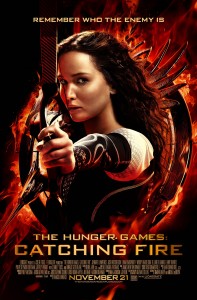
On Nov. 21 the long awaited second installment of the Hunger Games trilogy was released in public theaters, and racked up a record $161.1 million on opening weekend. Expectations ran high, with questions as to whether or not the film would accurately follow the book’s plot that many had come to know and love.
You can distinguish a devoted fan from a pretender by the way a person refers to the film, as Catching Fire or The Hunger Games 2. So let me tell you about Catching Fire.
The movie started with a sense of déjà vu, capturing Katniss Everdeen (academy award winner Jennifer Lawrence) in the woods hunting, her preferred setting. The film orients the audience to changes in Katniss’ life since becoming a victor of the Hunger Games, along with her District 12 partner, Peeta Mallark (Josh Hutcherson). The tension resulting from a confusing romantic predicament between these two, as well as Katniss’ other love interest, Gale(Liam Hemsworth), provide an awkward love triangle.
Katniss’ mother and sister (Primrose “Prim” Everdeen) play important roles in the book, but barely make an appearance in the movie, which was a disappointment.
The film then launches into a tale of survival not only with the upcoming Games, but also with the associated media exposure. President Snow (Donald Sutherland) stops by right before the Victory Tour to inform Katniss of a growing rebellion and her role in it, and issues her a warning, spurring the central conflict of the second film.
Throughout the tour, the victors see bits of the rebellion and do their best to become a distraction, as instructed by Snow. In the end, the effort is not enough, and new Head Game Maker, Plutarch Heavensbee (Philip Seymour Hoffman), gives Snow the idea to pull contestants for the next Hunger Games (which happens to be the 75th anniversary known as the Quarter Quell) from the pool of past victors.
Jennifer Lawrence’s interpretation of the stoic teen who reluctantly becomes the symbol of a revolution is nearly flawless.
She allows her own personality to shine through when Johanna (Malone) strips down naked in front of she, Peeta, and Haymitch in an elevator, and the audience is allowed one last comedic moment before the suspense intensifies with the Games.
The training arena was enhanced from The Hunger Games film, with electronic simulations to aid in practices as opposed to dummies. With the more experienced fighters in the gym, the displays of combat were a bit more advanced, and Katniss’ archery wowed other tributes, causing them to ask for her hand in alliance.
Katniss and Peeta, spurred by their mentor, eventually form a ragtag unit with unfamiliar allies, and Katniss suspects there is more going on, as Finnick (Sam Claflin) and Johanna (Jena Malone) make sure they stay a pack. She is right, of course, and the resulting complications and twists will take us into the highly-anticipated two-part presentation of the third book, Mockingjay.
Overall, Catching Fire was better than the original, satisfying fans by staying true to the plot of the book and showing the main characters (minus Prim and Katniss’ mother) as most of the fans imagined them. Slight additions, such as conversations between Plutarch and Snow in scenes that were not a part of the book, were forgivable. Small details (like the poisonous fog and jabberjay segments of the arena) were beautifully portrayed, and exceeded my expectations.
9.5 / 10: This high score is for book accuracy and execution.